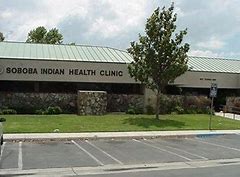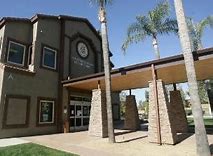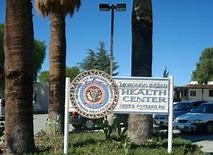Riverside San Bernardino Indian Health Inc. Optometry Residency Program Description



Established: 2020
Positions: 2
Riverside San Bernardino County Indian Health Inc.
11980 Mt. Vernon Ave.
Grand Terrace, CA 92313
909-864-1097
Program Faculty
Nha-Han Nguyen, OD
Residency Coordinator
951-654-0803x2280
npnguyen@rsbcihi.org
Chad Stockert, OD
Optometry Director
951-849-4761x1400
cstockert@rsbcihi.org
Attending
Dr. Jean Dinh
Dr. William Park
Dr. Richard Phan
Dr. Mallory Kennedy
Mission Statement
The mission of the Optometric Residency in Primary Eye Care with an emphasis in Ocular Disease is to provide the resident doctor with comprehensive education and clinical training in all aspects of primary care optometry, including but not limited to, advanced care and surgical procedures.
Program Description
The Primary Eye Care residency is 52 weeks in length. (August 1st – July 31st)
Riverside-San Bernardino County Indian Health, Inc. (RSBCIHI) consists of a consortium of nine (9) tribes located throughout Riverside and San Bernardino county service area. The consortium tribes are Agua Caliente, Cahuilla, Morongo, Pechanga, Ramona, San Manuel, Santa Rosa, Soboba, and Torres-Martinez. RSBCIHI’s services are provided to eligible Native American/Indian patients and their families. Eligibility is determined by the Board of Directors.
The mission of RSBCIHI is to provide culturally sensitive healthcare, respect and abide by traditional customs of our Indian communities, and promote wellness and provide early intervention to achieve healthy lifestyles. The Board of Directors and staff are working hand in hand with Indian communities to achieve our vision.
RSBCIHI consists of eight (8) locations: the main facility, which is home to RSBCIHI Administration, located in Grand Terrace (San Manuel Indian Health Clinic;) Anza (Cahuilla Indian Health Clinic;) Banning (Morongo Indian Health Clinic;) Barstow (Barstow Indian Health Clinic;) Mountain Center (Santa Rosa Indian Health Clinic;) San Jacinto (Soboba Indian Health Clinic.) Temecula (Pechanga Indian Health Clinic;) Thermal (Torres-Martinez Indian Health Clinic). Eye Clinics are currently located within seven (7) of the eight (8) locations (Anza, Barstow, Banning, Grand Terrace, San Jacinto, Temecula, and Thermal. Resident(s) will see patients at all sites with an Eye Clinic.
The Eye Care Clinics offer full scope optometric care with the resources of a inter-disciplinary environment. For example, our Electronic Health Record (EHR) system allows for our optometrists to access all available health information, including laboratory work, radiology reports, and progress notes. With EHR, optometrists can electronically order medications, consults, and laboratory and/or radiology studies. Completed imaging, such as ophthalmic imaging, CT and MRI scans, carotid Doppler studies, and automated perimetry results, are readily available through the imaging component of the EHR. In the event of abnormal laboratory or radiology results, the ordering provider is alerted, so that the results can be conveyed immediately. In this environment, multiple providers can communicate with one another easily, so that a patient’s care can be coordinated appropriately. If during a primary care visit, a patient is found to have an urgent problem that requires a referral, the patient is commonly seen in the referral clinic that same day. The referring provider is then able to view the results of the consult as soon as the record is electronically signed.
Weekly Schedules
Weekly hours depend upon clinical assignment for the week; residents are expected to rotate as needed throughout our clinical locations. Below is a list of the clinical sites and the hours of operation. There is no weekend or on-call duties required. The resident will work a total of 40 hours per week regardless of their clinical rotations.
San Manuel Indian Health Clinic:
11980 Mt. Vernon Ave.
Grand Terrace, CA 92313
Hours of operation:
Monday – Wednesday (8:00am – 5:00pm) (lunch 12-1pm)
Thursday – (8:00am – 7:00pm) (lunch 1-2pm)
Friday – (8:00am – 2:00pm) (no lunch)
Morongo Indian Health Clinic:
11555 ½ Potrero Rd.
Banning, CA 92220
Hours of operation:
Monday, Wednesday, Thursday (8:00am – 5:00pm, lunch 12-1pm)
Tuesday – (8:00am – 7:00pm, lunch 1-2pm)
Friday – (8:00am – 2:00pm, no lunch)
Soboba Indian Health Clinic:
23119 Soboba Road
San Jacinto, CA 92583
Hours of operation:
Monday, Tuesday & Thursday (8:00am – 5:00pm, lunch 12-1pm)
Wednesday – (8:00am – 7:00pm, lunch 1-2pm)
Friday – (8:00am – 2:00pm, no lunch)
Pechanga Indian Health Clinic:
47001 Pala Rd.
Temecula, CA 92390
Hours of operation:
Monday – Thursday (8:00am – 5:00pm, lunch 12-12:30pm)
Friday – (8:00am – 2:00pm, no lunch)
Barstow Indian Health Clinic:
170 Yucca Ave.
Barstow, CA 92311
Hours of operation:
Monday – Thursday (8:00am – 5:00pm, lunch 12-12:30pm)
Friday – (8:00am – 2:00pm, no lunch)
Torres-Martinez Indian Health Clinic:
66-655 Martinez Road
Thermal, CA 92274
Hours of operation:
Monday – Thursday (8:00am – 5:00pm, lunch 12-12:30pm)
Friday – (8:00am – 2:00pm, no lunch)
Cahuilla Indian Health Clinic:
53000 Cahuilla Road
Anza, CA 92539
Hours of operation:
Monday – Thursday (8:00am – 5:00pm, lunch 12-12:30pm)
Friday – (8:00am – 2:00pm, no lunch)
Residency Program/Requirements
Goal 1: Strengthen the residents’ primary eye care skills and advance their competency in ocular disease diagnosis and management
Objective 1: Ensure that the resident performs a vast array of primary care examinations.
Outcome: The resident will perform a minimum of 1,200 patient encounters.
Measure 1: The resident reports quarterly on the patient care log
Measure 2: The residency coordinators will review patient totals and diagnoses on a quarterly residency requirement log
Objective 2: Strengthen the residents’ ability to diagnose, treat and manage ocular pathology.
Outcome: The resident will examine a large number of patients with ocular pathology.
Measure 1: The attending doctors will supervise the resident and review/cosign all patient encounters
Measure 2: Using the Patient Encounter and Diagnoses Log, the resident reports quarterly on the diversity of clinical presentations encountered.
Measure 3: Resident logs are submitted quarterly to the affiliate and reviewed quarterly by the residency coordinator.
Objective 3: Incorporate advanced procedures and surgical techniques in the residents’ treatment options of ocular disease cases
Outcome: The resident will appropriately identify patients who are candidates for, and will competently perform, advanced procedures:
- Injectible Pharmaceutical Agents (Diagnostic & Therapeutic)
- Lacrimal Duct Probing/Dilation/Irrigation
- Immunizations
- Anterior Stromal Puncture
- Biopsy of Eyelid Lesions
- Closure of Tear Drainage Structures
- Corneal Curettage
- Entropion Repair by Suture
- Incision, Drainage/Curettage, Destruction & Removal of Non-Malignant
Conjunctival & Eyelid Lesions
- Punctoplasty
- Anterior Segment Laser Procedures (e.g. SLT, LPI, YAG capsulotomy)
Measure 1: The resident will successfully complete, and or, be involved in a minimum of 25 advance procedures.
Measure 2: Resident will document the procedure and their level of involvement into the Meditrek log. The logs are submitted quarterly to the affiliate and reviewed quarterly by the residency coordinator.
Goal 2: Encourage the residents to participate/engage in didactic educational activities to foster critical thinking and enhance decision making.
Objective 1: The resident will attend regularly scheduled optometry grand rounds, continuing
education courses, conferences, and other didactic activities (e.g. clinical workshops.)
Measure 1: Using the resident’s Meditrek activity log, the resident will record and report all educational courses and seminars attended.
Measure 2: The resident will be required to attend at least five (5) education courses and/or didactic activities outside of RSBCIHI Eye Care events.
Objective 2: The resident will periodically present case reports during optometry grand rounds.
Measure 1: The resident will participate in case report sessions held during regularly scheduled optometry grand rounds. Furthermore, the resident will be required to present at least one (1) time during said optometry grand rounds.
Measure 2: The resident will make at least one (1) presentation at grand rounds held at SCCO. Using the resident activity log, the resident will record all optometry grand rounds participation.
Objective 3: The resident will develop habits of lifelong learning and critical thinking through a review of ophthalmic literature, which the resident shall present at optometry grand rounds.
Measure 1: The resident will participate in quarterly literature review sessions during optometry grand rounds.
Measure 2: The resident will record all optometry grand rounds participation via Meditrek activity log.
Goal 3. Inspire the resident to conduct scholarly activities and promote the dissemination of gained knowledge to the professional and health community
Objective 1: The resident will participate in formal Primary Eye Care instruction to optometry students in a clinical, laboratory, and/or classroom setting.
Measure 1: Under the supervision of the program coordinator, the resident will provide instruction to no more than three (3) 4th year optometry students rotating through from Western University College of Optometry, Midwestern University Chicago College of Optometry, and Southern California College of Optometry
Measure 2: Resident logs are submitted quarterly to the affiliate and reviewed quarterly by the residency coordinator.
Objective 2: The resident will be encouraged to complete a poster presentation at a state, regional, or national meeting.
Measure 1: Although not mandatory, the resident will be encouraged to complete and submit an abstract to the American Academy of Optometry (AAO,) Southeastern Congress of Optometry (SECO,) Association for Research and Vision in Ophthalmology (ARVO,) or American Optometric Association (AOA.)
Measure 2: The residency program coordinator will review abstracts prior to submission and receive a copy of the final submitted abstract and/or poster.
Objective 3: The resident will complete and submit a research paper, literature review, or clinical case reports of publishable quality to the residency program coordinator by the end of the residency.
Measure 1: The resident will complete and submit a research paper, literature review, or clinical case reports of publishable quality to the residency program coordinator by the end of the residency. The process will be structured such that there will be clear deadlines on topic selection, first draft, and final manuscript due dates in order to enhance compliance.
SIGNIFICANT PROGRAM DEADLINE DATES
Topic selection: October 1st
Abstract: December 1st
1st Draft: March 2nd
2nd Draft: May 1st
Final Manuscript: July 1st
Goal 4. Provide opportunities for the resident to develop into an effective educator and preceptor.
Objective 1: The resident will precept fourth-year optometry interns in the clinical setting at the discretion of the Residency program coordinator(s).
Measure 1: Once deemed appropriate by the Residency program coordinator(s), at least one-half clinic day of the residents’ schedule per week will be designated for the resident to precept fourth-year optometry interns.
Goal 5. Foster the resident to embrace the culture of Native Americans and Indigenous people through recognizing public health issues and serving in community-oriented programs
Objective 1: The resident will participate in community-based vision/health screenings and/or discuss vision-related health care topics during patient education forums.
Measure: The resident will participate in at least two (2) separate events participating in either a vision screening and/or presenting on vision-related health care topic to patients (e.g. presenting on Diabetic Retinopathy at patient informational forum.)
• Completion of all required residency/preceptor evaluation
Residency Completion Requirements:
1) Resident must complete program requirements for patient encounters, showing steady improvement and satisfactory delivery of patient care throughout the residency.
-a minimum of 1200 patient encounters
-a minimum of 25 advanced procedures.
2) Resident must regularly attend scheduled optometry grand rounds, CE, conferences or didactic activities including
-a minimum of 5 educational courses/activities outside of RSBCIHI events
-a minimum of 1 presentation during RSBCIHI grand rounds
-Present at SCCO residency forum
3) Timely submission of required paperwork including all quarterly paperwork/reviews
-Resident Self Assessment
-Patient Encounter Log
-Resident Activity Log
-Resident Referral Log
-Resident Reading Log
-Resident Faculty Evaluation
-Resident Program Evaluation
4) Completion and submission of a research paper, literature review, or clinical case report of publishable quality.
5) Resident must participate in a minimum of 2 community-based vision/health events.
6) Turn in all required badges/keys.
Stipend
The annual Stipend is determined by our internal HR department and is currently set at $52,530 for the current academic year.
Benefits
Health Coverage – Optional health insurance is offered; biweekly premiums will be deducted
Liability – Residents are covered under Federal Tort Law
Vacation/Sick Leave – 6.25 hours accrued every 2 weeks.
Educational Travel – stipend available with up to 40 hours of pay for CE
Holidays – All federal holidays except for Columbus Day (this is replaced by California Indian Day). New Year’s Eve/New Year’s Day, Martin Luther King Day, President’s Day, Memorial Day, Juneteenth, Independence Day, Labor Day, California Indian Day, Veteran’s Day, Thanksgiving Holiday, and Christmas Eve/Christmas Holiday.
Life Insurance – Optional and available; biweekly premiums will be deducted
Application Requirements
A letter of interest, curriculum vitae, official transcripts, NBEO scores, three letters of recommendation, and on-site or phone interviews are considered for selection. Applications are submitted through the OR Match Service. Potential residents will be contacted to schedule interviews.
Selection Procedures and Admission Criteria
Admissions eligibility criteria must include the requirement that prior to matriculation applicants must have attained the Doctor of Optometry (O.D.) degree from a school or college of optometry accredited by the Accreditation Council on Optometric Education.
Applicants must have passed Parts I and II of the NBEO examinations (including TMOD), and have attained the Doctor of Optometry (O.D.) degree from a school or college of optometry accredited by the Accreditation Council on Optometric Education by August 1 of the residency year. Although not required, preference will be given to applicants who have passed Part III of the NBEO examination as well.
A letter of interest, curriculum vitae, official transcripts, NBEO scores, three letters of recommendation, and on-site or phone interviews are considered for selection. Applications are submitted through the OR Match Service. Prior to residency completion, the applicant is required to obtain state licensure.
The ranking process for candidates considers all aspects of each application. While academic performance is heavily emphasized, additional consideration is given to candidates who demonstrate strong character, interpersonal skills, professionalism, and integrity. Once candidates are interviewed, a ranking will be assigned and sent to ORMatch prior to the matching deadline. In the event no match occurs, the selection process will continue outside the ORMatch matching system. Qualified candidates will be encouraged to apply.
Program Accreditation
The Accreditation Council on Optometric Education (ACOE) has granted the Riverside San Bernardino Indian Health Inc. Optometry Residency Program the accreditation status of “Accredited.” The next scheduled site visit will take place in June 2029. Accredited is a classification granted to an educational program indicating that the program generally meets the Standards for accreditation. For more information, see the ACOE’s website at www.theACOE.org or contact the ACOE at accredit@theacoe.org.
Accreditation Council on Optometric Education
243 N. Lindbergh Blvd., Suite 301
St. Louis, MO 63141
Phone: 1-800-365-2219
E-mail address: accredit@theacoe.org
Housing
All clinical locations are throughout Riverside and San Bernardino Counties, residents will be required to rotate through all clinical locations, as such, it is recommended that residents find housing at a centralized location. The best options for this would be around Riverside, CA.
Local Activities and Attractions
Southern California is known for its weather and laid back lifestyle. You are ~1 hour from the beach, the mountains and the desert and as such, there are plenty of activities available to you, these include many National and State Parks. As an example: Joshua Tree National Park, Cleveland National Forest, San Bernardino National Forest, Big Bear, and California National Seashore to name a few. Along with this, you are close to many well-known attractions including: DisneyLand, Sea World, Knott’s Berry Farm, Universal Studios and Six Flags Magic Mountain.
Current Residents
Herlyn McIntosch, OD
Western University College of Optometry
hmleiva@rsbcihi.org
Gerard Sim, OD
Western University College of Optometry
gjbsim@rsbcihi.org
For More Information:
Nha-Han Nguyen-Deo, OD
RSBCIHI – Soboba
23119 Soboba Road
San Jacinto, CA 92583
951-654-0803 x2280
npnguyen@rsbcihi.org
Chad Stockert, OD
RSBCIHI – Morongo
11555½ Potrero Rd.
Banning, CA 92220
951-849-4761x1400
Judy W.H. Tong, OD
Assistant Dean of Residencies
Southern California College of Optometry at
Marshall B. Ketchum University
2575 Yorba Linda Blvd.
Fullerton, CA 92831-1699
714.449.7429 • Fax: 714.992.7811 • Email: jtong@ketchum.edu
